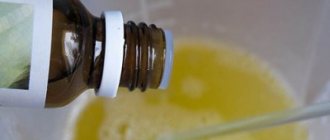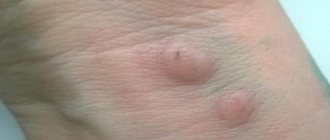Choice of product
Dogs are more vulnerable to parasites, including ticks. There are several ways to simplify this - periodic treatment for prevention. To do this, you can use ready-made purchased medications that your veterinarian will recommend. But it is worth understanding that chemicals will have a negative effect on the pet’s body.
This is why most dog breeders try to protect their dogs from ticks using folk remedies. Dogs can be treated with various substances of their own production; it is important to strictly maintain the proportions and apply the products strictly according to the recommended schedule.
Folk remedies against ticks are less concentrated, so in order to protect your pet, treatment will need to be carried out before each walk.
You can prevent the appearance of parasites using several types of means:
- essential oils;
- infusions;
- tar soap.
Each of them can be used either individually or in combination before and after walking your four-legged pet in the fresh air.
Processing methods
The most important thing is that when treating a pet, two rules are followed:
- You should be comfortable using the prepared emulsion.
- The product should not come into contact with the mucous membranes of the animal (and yours too).
Application by hand
The product can be applied a little bit onto the palm of your hand and distributed over the dog’s fur. It is better to do this against the growth of the hair, so that the ether gets not only onto the surface, but also into the thickness of the fur. Before the procedure, it is advisable to wear rubber gloves, although if the smell on your skin does not bother you, you can do without them. After treatment, the dog's fur needs to be combed.
But before application, the active substance must be added to the base oily base. It can be any vegetable oil, but it is better to take almond oil. It contains sulfur, which also has some acaricidal effect. For 2 tablespoons of base oil, take 10-15 drops of the essential mixture.
When treating your dog with tick and flea preparations based on essential oils, do not forget about the paws!
Using a spray bottle
There is another way and, in my opinion, it is more convenient and rational. The composition is prepared from water (1 glass) and a teaspoon of essential oils. The emulsion is poured into a spray bottle. It is advisable that it be fresh every time.
Before a walk, this liquid is shaken and sprinkled over the animal’s fur. Just remember to lift the hair to thoroughly treat the entire cover. And also the wool needs to be combed so that the product is evenly distributed.
Collar processing
There is another method that is more often used to protect against fleas. The essential oil or mixture is applied to the dog's collar. Periodically you need to drip again, as the esters quickly evaporate. Using this method, you cannot remove existing fleas, but you can scare off the “new ones.”
Using Shampoo
To enhance the repellent effect, you can use a detergent with essential oils when bathing your dog. It is done very simply - add a few aromatic drops to the amount of shampoo required for washing. How much shampoo you need depends on the size of your dog. In this case, take 15 drops of the essential mixture per 100 ml of washing liquid.
You can use any shampoo. But I can tell you that the experienced veterinarian who sees our dog gave us advice to wash the dog with human shampoo, and not with the one they sell in the pet store - like this...
Although you can still take tar shampoo - it also has a preventive effect against subcutaneous mites. Tar, by the way, can also be bought in a regular cosmetics store, and not in a zoo.
I recommend reading:
How to remove tear tracks from a dog
Removing a tick
If treatment against exoparasites was carried out at the wrong time and the tick still burrowed into the dog’s skin, then there is a way to remove it using essential oil. A few drops of oil ether are applied to the embedded parasite. Tea tree, lavender or thyme are suitable for this purpose. The tick is pulled out with a gentle movement, turning counterclockwise.
There are different ways to protect your dog from ticks and fleas. If essential oils are suitable for your pet and you, then this method should not be discounted.
Health to your pets!
Flea and tick oils
Remedies on this basis are not a panacea for already acquired parasites. Due to their rich smell, they will repel blood-sucking individuals, thereby preventing pests from getting on the fur and skin of pets. Among breeders and veterinarians, the following plants are recognized as the most effective anti-tick essential oils for dogs:
- tea tree;
- carnations;
- juniper;
- pennyroyal;
- rosemary;
- thyme;
- eucalyptus;
- rosemary;
- lavender;
- cedar;
- citronella;
- geraniums
Oils against fleas and ticks
Pennyroyal is not used to treat puppies or expectant mothers. You should treat your dog against ticks carefully, as some options can cause allergies in your pet. Immediately after the first treatment, it is necessary to observe the dog for an hour; if it becomes irritable or, on the contrary, too calm and lethargic, then this drug should not be used anymore.
Applying anti-tick oil is simple, just drop a few drops of the chosen product on your hands, rub a little and treat your pet's fur against growth. Such movements can be done several times, but you should not add funds.
Animals have a much more sensitive sense of smell than humans, so the concentration of the product is chosen to be minimal.
Let's group repellent essential oils:
The Campers Guide to Essential Oil Bug Repellent divides them into the following groups:
| From mosquitoes: | For fleas: | From ticks: |
| Citronella, cedar, lemongrass, mint, eucalyptus, lemon, geranium, basil, lavender, thyme, cloves | Cedar, tea tree, citronella, eucalyptus, lemongrass, orange, lavender, pine | Lavender, lemon, cedar, geranium, eucalyptus |
Infusions
Dogs are also protected from parasites with infusions. These DIY tick repellents have been found to be no less effective than oils.
You can protect your dog from bloodsuckers with the following infusions:
- Wormwood is the main enemy of all parasites; just 20 g of fresh grass per liter of water can repel ticks and fleas from your four-legged pet. The ingredients are combined, brought to a boil, and cooled. Strain and apply with a spray bottle before each exit to the street.
- You can prepare another infusion at home; it contains vanillin and vodka. For every 2 g of dry matter, take 100 g of alcohol, mix well and keep for 10 days in a cool, dark place. Next, the mixture is poured into a container with a sprayer, treatment is carried out every day before going outside.
- You can also fight parasites with garlic water; to prepare it you will need half a liter of liquid and three cloves of garlic. Peeled and chopped garlic is placed in water and left for 8 hours, then applied to the back and withers of the animal before each walk. It is not recommended to treat other parts of the body; the dog will be able to lick itself.
Folk remedies for dogs against ticks
You can also treat your dog against ticks using combined means; essential oils are often added to infusions. Before conducting such experiments, it is necessary to consult a veterinarian; he will be able to give effective advice on combining substances.
Allelopathic effect of essential oils
It has been noted for quite some time that plants can influence each other. There is even a whole science that studies this interesting natural phenomenon, and it is called allelopathy. Research has shown that many essential oil plants have this property. For example, when sowing clary sage in the same field, the plants develop poorly, and the seedlings turn out to be very unfriendly. When sowing catnip together with other crops, it was noted that it has a positive effect on the initial growth of Moldavian dragonhead, wheat, buckwheat, coriander, dill), and in the marked marigolds (Tagetes signata) growth slowed down.
On the other hand, essential oil has a negative effect on the germination of radish seeds and the growth of watercress and wheat seedlings. In high concentrations (10 μl/Petri dish), catnip oil and its vapors reduce the germination of these crops by 80 percent or more. The aqueous solution is more active than the volatile fractions. The lowest concentration (1 µl/Petri dish) completely inhibits the growth of watercress roots. Plant growth responses are more sensitive to essential oils than seed germination. The root system is more sensitive than above-ground organs. Suppresses the growth of fungi in the soil.
Photo: Andrey Shchukin, Maxim Minin, Rita Brilliantov
Washing with special products
If none of the proposed options suits you, you can try washing your pet after each walk with special products of natural origin. This method will protect your dog from ticks and fleas 100%.
Washing is carried out with several means to choose from:
- Tar soap will help remove ticks from your dog that have not yet burrowed into the skin. Disinfection is carried out due to the main ingredient - birch tar, which will not allow ticks or fleas to settle on the animal. This product can be used even on small puppies, and the soap is absolutely harmless to humans. You can simply soap with your hands, without using protective gloves.
- To protect the animal from parasites, after a walk it is washed with regular shampoo, to which essential oils are added, depending on the container. In a standard bottle of 250-300 ml, only 3-5 drops are enough. The product must be shaken well before application, then the effectiveness will be at the proper level.
Recipes for treating dog hair
- Dissolve 1/3 teaspoon of tar soap in 250 ml of water, add tea tree oil, cloves, juniper, grapefruit and thyme. Esters are added 2 drops each. Shake the solution well before use.
- Mix tea tree and thyme oil, 2 drops each, citronella and lavender, 3 drops each. This product helps not only against ticks in dogs, but also against fleas. The mixture is added to oil or water (50 ml).
- Lavender and thyme - 1 drop each, eucalyptus - 2 drops. Essential oils are dripped into vodka (1 teaspoon). The total amount depends on the size of the dog. This product is used once a week.
Traditional methods of treatment
When it was not possible to protect the pet, signs of subcutaneous mites are detected, treatment is necessary. Many pets react negatively to drug therapy options, and for some breeds they are generally contraindicated. It is in such cases that folk remedies are used. They are used depending on what type of tick the dog has.
Protection against ixodid ticks
Ixodid ticks appear on your pet's body after a walk; they can be removed by bathing with tar soap or shampoo with the addition of essential oils.
If the tick is deeply ingrained into the dog’s skin, then essential oil in its pure form will help remove the parasite. The problem area is generously lubricated with one of the above oils and the parasite is removed using tweezers in a circular motion.
Washing the dog
Subcutaneous mites
These parasites can be eliminated without the use of medications. There are several options:
- An infusion of celandine roots will be irreplaceable; the washed and purified raw materials are poured with sunflower oil in a 1:1 ratio. Maintain at a temperature of 50 degrees for at least 4 hours. The strained infusion is applied to problem areas daily.
- Juniper berries and sour apples are crushed into puree, mixed well and applied to the affected areas.
- Sour cream or kefir with black sulfur also have healing properties; the ingredients are mixed well in a 3:1 ratio.
- Birch tar will cope perfectly with the problem; the product is applied directly to the affected areas daily.
According to reviews, all of the above methods are effective, but before using them you should consult a veterinarian. This will allow you to choose the most suitable treatment option and not harm the dog.
List of effective oils against ticks
Humanity has long used aromatic extracts from plants; their properties and composition are studied by modern science. Some protect against ticks in the best possible way, while others, on the contrary, have almost no effect on them.
There are plants whose odors provide the most effective protection against bites. All of them can be used individually or in combinations that increase their effectiveness.
Cat mint
This plant of the Lamiaceae family is also called catnip. The ether content in its leaves and stems reaches 3%, and in the seeds – up to 27%. The main component is nepectolone, in addition to it there is ascorbic acid, tannins, and glycosides. The smell of catnip is very attractive to cats and is hated by ticks.
Citronella
The smell of Java citronella is similar to that of lemon, so another name for the plant is lemon balm, or lemon grass. The aroma of citronella, in addition to citrus, is filled with notes of freshly cut grass.
Lemon eucalyptus
Repels arachnids with a guarantee. The aroma of this plant is similar to the smells of verbena, lemon, thyme, and lemon balm. In addition to active protection against bloodsuckers, it has an antiseptic effect and helps heal wounds. The plant itself is native to tropical Australia and is now often grown as a home plant.
Thyme
Fragrant thyme, or thyme, can often be found in a country house or flower bed. It's beautiful and smells nice. Thyme herbs and seeds are used in the preparation of various dishes, and the essential extract has been used in aromatherapy since ancient Egypt. Its deep spicy woody-herbaceous aroma is not to the liking of insects and arachnids.
Carnation
Spice, dried flower buds of the clove tree, growing in tropical regions. Clove essential oil is an unparalleled antiseptic. It is actively used in folk medicine and cosmetology. It heals wounds, relieves coughs, and relieves pain. It is strictly forbidden to use it in its pure form, as there is a high risk of burning the skin or mucous membranes.
Tea tree
The features of this ether have been fully explored only recently. It has antibacterial, antiviral, wound healing, anti-inflammatory effects. At the same time, the product does not damage healthy skin, is not an irritant, and is hypoallergenic.
Geranium and lavender
Geranium essential oil is very light, transparent, bright green in color, with a fruity base and bitter notes. The aroma of lavender is calming and relaxing. In addition to perfume, it also has antiparasitic uses.
Ticks really do not like the smells of geranium and lavender oils and avoid places with these plantings.
Neem essential oil
This ester is a natural pesticide obtained from the seeds of the neem tree. Yellow-brown in color, bitter in taste, its aroma is a mixture of sulfur and garlic. It is an excellent substitute for chemicals and can easily deal with ticks. Unlike others that simply repel parasites, neem extract kills those that do not have time to crawl away.
Cedar
Cedar oil is obtained from the bark and young branches of different types of cedar using steam distillation. Viscous, amber in color, with the smell of resin, smoke and wood, it does not allow ticks and blood-sucking insects to approach humans. Not recommended for use if your child is under 12 years old.
Other
In order to repel ticks, other esters are used: anise, fir, juniper, rosemary.
Separately, it is worth noting eucalyptus oil against ticks. This remedy is considered one of the most effective in the fight against parasites. It has the properties of a pesticide, so it will not only repel parasites with its smell, but will quickly weaken or destroy a tick that gets on the skin or clothing.
Reviews
I have had dogs in my house since childhood, even then the dog was the family’s favorite. It is from there that I know several methods for preparing natural infusions that will not allow a single tick to cling to an animal. I consider wormwood to be the most effective; only it, as my practice has shown, repels these pests most effectively.
I always wanted to have a dog, but I never thought about what a responsibility it would be. The hardest thing for me in care was getting rid of parasites. I tried many pharmaceutical products, but the effect was temporary. I learned about essential oils against ticks from a veterinarian, and since then they have been my dachshund’s best friends.
Regular tar soap helped rid my pet of fleas and protect me from ticks. Previously, with every walk we brought such “tenants”, getting rid of them became a real problem. Now, upon arriving home, it is enough to wash your pet in the bathroom with soap, the problem goes away on its own. I recommend.
There are many folk remedies for preventing the appearance of ticks in dogs and eliminating them. The main thing is to strictly adhere to the proportions and first consult with a veterinarian.
Tick season
When the temperature drops below seven degrees, ticks go into hibernation and thus wait out the frosts without any problems. The peak activity of ticks in Moscow and the Moscow region falls mainly in May-June and August-September.
Of the approximately 40 thousand ticks, only taiga and European forest ticks are considered dangerous to humans. Ixodes ticks (Ixodes damini) feed on the blood of mammals - carriers of about one and a half hundred different diseases, in particular the most common Lyme disease, also called tick-borne borreliosis.
Ticks usually settle in tall and dense grass, but they can hide in summer cottages:
- in firewood;
- in abandoned branches;
- in heaps of garbage;
- in greenhouses.
There are many chemical insect repellent sprays available to combat ticks, as well as natural repellents such as coconut oil.
What scents repel ticks?
There are repellent substances that repel these blood-sucking arthropods. Specialists from the sanitary service of the Altai Territory, where tick attacks on humans and domestic animals are often observed, have determined which essential oils repel ticks:
These aromas are characterized by a sour, spicy or bitter odor. Therefore, several more oils are isolated, which, due to the similarity of their characteristics, are also used to protect against parasites:
- anise;
- basil;
- carnation;
- geranium (palmarosa);
- lavender;
- lemongrass;
- cedar tree oil;
- Melissa;
- myrtle;
- juniper;
- fir oil;
- rosemary;
- thyme;
- citronella.
All of them make ticks feel threatened, so they tend to move further away from the source of the smell.
Using essential oils of mint, lavender, tea tree and other plants is good protection against ticks
Security measures
Essential oils against ticks
The main rule for using any essential oil is to do a test before applying it directly to the skin to find out if a person is allergic to the ingredients of the mixture. To do this you need to mix 1 tsp. any vegetable oil and 1-3 drops of the selected essential oil, anoint it on the wrist or inner forearm.
Important!
You need to monitor your condition for at least 12 hours: if during this time redness or itching appears, then this aroma mixture is not suitable.
Another way to test for allergies is a breath test using a cotton swab soaked in 1-2 drops of essential oil. If when you bring it to your nose and take 8-10 inhalations of flavored air for 5 minutes. If there is no dizziness, cough or shortness of breath, or increased heart rate, then it can be safely used.
You should also be aware that some types of essential oils are not recommended for use in the following situations:
- Do not apply to skin in very hot weather;
- When spraying the spray, make sure that the product does not get into your eyes;
- During pregnancy, it is not recommended to use essential oils of lavender, juniper, mint and lemon balm;
- for hypertension - exclude mint, basil and juniper;
- for hypotension - do not use lemon, lemon balm and tea tree;
- for patients with epilepsy and kidney disease, the aromas of thyme, rosemary and basil are contraindicated;
- When using preparations with iron and iodine, you should exclude lavender oil.
Ways to use essential oils
The first thing to do is to test yourself for sensitivity by placing a few drops of the aroma mixture (1 drop of oil per teaspoon of base) on your wrist or inner forearm. If you do not notice any redness or itching on your skin within 12 hours, feel free to use this essential oil. Perform a breathing test for allergies: apply 1-2 drops of essential oil to a cotton swab, bring it to your nose and take 7-10 breaths. If within 5 minutes there is no dizziness, shortness of breath, cough and the pulse does not increase, use the oil.
Various forms of protective equipment are used:
- Aroma mixture - essential oil or a mixture of two or three types in equal proportions with base vegetable oil - sunflower, corn or other:
- basic - 2 tbsp. l. (if you plan to apply the composition to the dog’s fur, use sweet almond oil);
- essential - 10–25 drops.
- Spray:
- oil - 10 drops;
- cologne - 50 ml (or 200 ml of water with 1 tsp of alcohol).
- Shower oil:
- essential oil - 15 drops;
- soybean - 5 ml;
- shower detergent - 30 ml.
Essential oils are practically not used in their pure form, as they have an irritating effect on the skin.
Repellent mixtures are stored in a glass or ceramic container for up to six months in a cool, dark place. Do not apply a lot of product if you do not plan to visit tick habitats every day.
Use natural rather than synthetic essential oils. They are easy to identify: they have good transparency, evaporate slowly (except for citrus fruits) and do not leave stains. To test this, take a piece of blotting paper, drop some oil on it and wait for it to evaporate. sukceso: 11/23/2017, 6:06 pm cosmetic will not have the desired effect. It is most often prepared on a synthetic basis. I myself use essential oils and I know that natural ones are effective, even if diluted with a base oil to reduce the concentration “>If there is a greasy stain on the sheet, this is a fake. The natural product may leave small stains colored with pigments.
Advantages of use and methods of application
Essential oils against ticks
Benefits of using essential oils against ticks:
- availability of this method;
- higher safety of use, because chemical protection products can cause allergic reactions, especially in young children;
- speed of application and effectiveness, because the product applied to the skin immediately begins to repel ticks and other blood-sucking creatures and its effect lasts up to 24 hours;
- long shelf life of the prepared mixture – up to 6 months.
There are several ways to apply essential oils against mosquitoes and ticks to your skin or clothing:
- using a soaked cotton swab;
- using a wet wipe, which is important when there are no other convenient aids;
- You can also use a roller for cleaning clothes: it is moistened with essential oil and passed over the surface of the clothes several times; the advantage of this technique is the uniformity of the applied layer of repellent;
- It is recommended to spray clothes in advance and put them in a plastic bag, blocking air access, for a day;
- spray the mixture as a spray from a bottle with a dispenser;
- wearing a repellent bracelet with essential oil applied to it against ticks; a product made of leather or wood onto which the aroma mixture is applied is suitable as a base; the great advantage is that the product does not need to be applied to the skin, which means allergies can be avoided.
Important!
Before applying essential substances to clothing, you should do a test on a small area hidden from view to make sure that no traces will remain on the fabric.
Instructions for using essential oils
To avoid being attacked by small bloodsuckers while walking, moisten a piece of gauze with a few drops of the prepared product and put it in your pocket. Before leaving the house, thoroughly treat your clothes with the aromatic mixture:
- Apply a few drops of the prepared mixture to exposed skin, avoiding contact with mucous membranes. Do not forget that pure oil cannot be used.
- Pre-treat clothing by spraying with a spray, hand-wetting it with a repellent essential oil mixture, or applying repellent with a roller.
- It is better to apply the protective composition the day before your walk: spray the mixture inside a plastic bag with a spray bottle, then put things in it and close the bag.
The scent of clove oil effectively repels ticks
To protect your pets:
- Apply a few drops of the prepared composition to your palms, rub and gently spread against the grain over the entire croup, head and limbs of the animal, and then comb the fur well.
- Spray the spray onto the pet's body using a spray bottle (similar to the previous point).
- Place a few drops of essential oil or mixture into your dog or cat's collar before going outside.
- Before a walk, bathe your pet with regular or tar shampoo, to which a mixture of oils has been added in the ratio: 15 drops per 100 ml of detergent.
The repellent effect lasts for 3–5 hours. If you are going to walk longer, take with you any of the products that will be convenient to use in hiking conditions, and re-treat yourself and your animals.
Both people and animals should not use the same essential oil daily for longer than three weeks. A break of 7–14 days is required. Therefore, change the composition of the mixture by making different compositions.
Contraindications and safety measures
Along with their undoubted benefits, essential oils can cause undesirable consequences. Be careful when using essential oils in the following cases:
- sukceso: 11/23/2017, 6:22 pm The article is devoted to the use of essential oils against ticks, so giving other recommendations is not entirely on topic. According to the sources that I took as a basis, these oils change hormonal levels (https://zhitiemoe.com/efirnie-masla/protivopokazaniya-pri-ispolzovanii-efirnyih-masel) “> sukceso: 11.23.2017, 19:59 By pregnancy in all sources - contraindications: https://zhitiemoe.com/efirnie-masla/protivopokazaniya-pri-ispolzovanii-efirnyih-masel. Other means of protection, besides essential oils, are not covered by the topic of the article, therefore I do not suggest “> during pregnancy, including in dogs, exclude lavender, lemon balm, juniper, and mint oils from the list of repellents;
- if you suffer from hypertension, the aromas of mint, juniper, and basil are prohibited;
- for low blood pressure - do not use lemon, lemon balm and tea tree;
- for kidney disease and epilepsy, the smells of basil, thyme and rosemary are contraindicated;
- When taking iron or iodine supplements, exclude lavender oil.
Also follow safety rules when using aromatic mixtures:
- To avoid irritation, sukceso: 11/23/2017, 6:24 pm do not use a spray, but another method of protection: apply to clothing “> do not apply the spray to the skin in hot weather, but treat clothes with it.
- Follow clear recommendations on the ratio of oils to base components.
- If skin irritation occurs, reduce the concentration of essential oil.
- Protect your eyes with goggles when using the spray.
- If you were careless, sukceso: 11/23/2017, 6:25 pm I checked with several sources. This surprised me too. But natural oil does not dissolve in water, so you can’t wash it out with water “>and essential oil gets into your eyes, carefully rinse them with purified corn/olive oil, and then with boiled water. You can also instill Albucid or Sofradex eye drops. After this, apply Hydrocortisone ointment according to the instructions.
- When treating animals with essential oils, monitor their reaction. If you notice irritability or other changes in behavior, do not use this remedy again. Just as you would for yourself, test your pet's tolerance to specific oils.
Oregano
Oregano essential oil wins in several ways. It contains cedrol, which can kill 100 percent of the ticks it comes into contact with when used in high doses. Cedar oil also contains cedrol and may be useful in protecting against ticks.
Carvacrol, a component of oregano oil, is very effective in killing Borrelia burgdorferi, the bacteria that causes Lyme disease. This can be of double benefit in case of a tick bite.
Oregano oil may cause skin irritation in some people. Like all essential oils, oregano oil should be diluted in a carrier oil. Be sure to do a patch test before using it on a large area.
How to Use Oregano Oil as a Tick Repellent
To use oregano oil as a mite repellent, mix 5-6 drops for every ounce of carrier oil and apply to exposed skin using a cotton ball.
You can also spray the oregano oil mixture directly onto clothing such as pants, socks, jackets, and hats. Ticks often fall from trees, so it is necessary to protect your head.
Do not use oregano oil on delicate fabrics that may stain.
Never apply undiluted oregano oil directly to your skin. First you need to dilute it.
Reviews
Today we walked on Oktyabrsky Island and removed 3 ticks from the dog. True, we haven’t gotten into it yet. The dog was treated with Bars drops and spray. I only sprayed my face with tea tree oil. There were none on the face.
Pusha
https://yk.kz/forum/archive/index.php/t-8573.html
I tried applying an essential oil recommended for ticks - geranium oil - just a few drops (no more!) on the collar to see if it would help. From that day on, we began to find from 20 ticks to zero ticks on dogs. ... I put just one or two drops - no more than pure essential oil - on my collar once a week, and there were really no ticks. Consult your veterinarian before using essential oil on cats.
good luck
https://wap.uaksu.forum24.ru/?1–13–440–00000012–000–120–0
Essential oil Eterika “Citronella” - I bought this particular oil as a repellent against ticks and mosquitoes. I also use it as a perfume. Advantages: I confidently use vinegar as an effective protection against mosquitoes and ticks for a small child. The good smell of the oil allows it to be used in cosmetics, aroma lamps and many other places.
Rusalochka2016
https://otzovik.com/review_5351652.html
Essential oils are effective natural remedies against small and dangerous bloodsuckers. When using them to protect against ticks, consider contraindications and do not neglect precautions.
How to use essential oils for dogs?
Pets also need protection from blood-sucking parasites, especially since dogs are much more likely to “catch” a tick than their owners. Extracts of eucalyptus and tea tree will help against ticks for dogs. By dropping a couple of drops on the collar, you will reliably protect your faithful dog. Apply the product carefully, observing the animal's reaction. If a spray is used, try to avoid spraying the face.
Veterinarians also advise using extracts from cedar, sage, bergamot, rosemary, and geranium to protect dogs. At the same time, note your pet’s attitude towards a particular scent. Each dog has its own preferences.
We use essential oils against ticks for people and dogs
With the onset of warm days, many people want to go outdoors. Unfortunately, holidays outside the city, despite all its attractiveness, are accompanied by encounters with ticks, the activity of which has been very high lately. Tick sucking is not only unpleasant in itself, but also poses a considerable danger, since they are carriers of such serious diseases as encephalitis, borreliosis, ehrlichiosis, so it is extremely important to protect yourself from their bites. Essential oils are an effective means of protection, the use of which will protect against tick bites without endangering human health. You can find a list of essential oils for ticks and how to use them in this article.
Why is essential oil protection against ticks better than store-bought sprays?
Most commercial repellent sprays contain a dangerous component called diethyltoluamide. A pharmacological study at Duke University found that rats given the average human dose of diethyltoluamide (40 mg/kg body weight) had difficulty performing tasks requiring muscle control, strength, and coordination. It was discovered that because of DEET, neurons actually died in the areas of the brain that are responsible for muscle movement, learning, memory and concentration! (source)
Of course, rats are much smaller than people, but this does not mean that we are out of danger. Children are especially at risk of brain damage because their skin absorbs diethyltoluamide more easily.
Another study found that DEET-based repellents have a good natural alternative: geranium essential oil. In this case, the effect of fragrant pelargonium , which is still produced in very small quantities and is almost inaccessible to the average buyer. But ordinary geranium oil also works well as an aid against ticks. Not only does it smell nice, but it also helps with inflammation and irritation - an ideal choice for people with sensitive skin!
Essential oils that repel ticks
Nowadays, stores provide a wide range of products designed to repel ticks. But they all contain chemicals that are sometimes neurotoxic, are applied only to clothing, and in most cases have a strong, unpleasant odor. In contrast, natural essential repellents are safe for people and pets, can be applied directly to the skin, and have a pleasant aroma. The effect of their use appears immediately after application, you can immediately go for a walk in the forest or field.
Geranium, basil, thyme, clove, rosemary, cedar, peppermint, and rose oils are excellent for protecting against ticks. Also repellent for ticks are litsea, eucalyptus, citronella, and tea tree oils.
Methods for applying essential oils against ticks
There are several ways for people to apply anti-tick essential oil. The first is to apply it directly to the skin. To do this, you will need to mix a couple of tablespoons of vegetable oil and 15-30 drops of essential oil.
The advantages of this method are:
- availability;
- safety;
- efficiency;
- speed of application;
- significant shelf life, since the solution prepared in this way can be stored for up to six months.
Before trying this method, you need to make sure that the person for whom it is used is not allergic to the ingredients included in the solution.
Another option for applying tick repellent is a spray. It is very easy to prepare an anti-tick aerosol at home; to do this, you need to mix a glass of water with two teaspoons of geranium or palmarosa oil, add a little alcohol, and pour the resulting solution into a spray bottle. We especially cannot replace such a spray on a hike, when it is necessary to treat equipment so that ticks, having caught on it, do not subsequently crawl onto a person. It is recommended to apply the prepared solution to objects that have direct contact with the ground: tents, camping rugs, towels, dog beds.
The advantages of this method are:
- ease of preparation and use;
- safety;
- high efficiency;
- availability of ingredients.
You can also use a clothes roller with adhesive tape to apply a natural tick repellent. It is enough just to moisten the device with oil and rub it several times over the clothes. This method will ensure that the natural repellent is evenly applied to clothing, which will prevent the tick from reaching unprotected areas of the body.
Interesting? Read what else you can use essential oils for.
The advantages of this method of application:
- effectiveness, which is achieved by evenly distributing the product over clothing;
- simplicity, because the use of additional ingredients is not required.
Before using this method, you need to make sure that the oil will not leave marks on the clothes, for which it is recommended to first apply it to a small hidden area of the fabric.
For people, essential oil to protect against ticks can be applied with a damp cloth, which is especially important if there are no other auxiliary products at hand.
If you don’t want to apply oil to your skin, you can make a tick-repellent bracelet with essential oils at home by applying a few drops of the drug to a leather or wooden item.
You need to apply a natural repellent using the methods listed above before visiting places where there is a danger of insect suction.
How to make tick repellent from essential oil for people at home
Before you make an essential oil anti-mite remedy, it is important to make sure it is right for you. Some essential oils, including citronella, can cause redness and irritation when in contact with the skin. Try applying the finished product on a small area of skin and only after there has been no reaction for an hour, use it on the entire body.
In addition, you should also like the smell, since you will be inhaling it for several hours in a row. Aromas such as mint and lavender have the most beneficial and calming effect on the psyche. In combination with lemon and other citrus fruits, they are even used to relieve headaches. Read more about this in our article Aromatherapy at home .
Read on to learn how to use essential oils for ticks:
Natural water repellent recipe
The water-based product is convenient because it can be sprayed onto the skin or clothing without fear of leaving greasy stains on it.
Ingredients:
- 60 ml. apple cider vinegar or vodka;
- 60 ml. water;
- 20-40 drops of your chosen essential oil (geranium, citronella, lemon eucalyptus, catnip or a mixture of these);
- 1/2 tsp. glycerin - optional (it makes the smell more persistent).
Essential oils do not mix well with water, so they are first added to apple cider vinegar or vodka. Shake well, then add water and pour everything into a glass or PET plastic spray bottle. Please note that essential oils can leach chemicals from some plastics, so the above containers are preferred over all others.
Repellent recipe with base oil
Your protection against ticks with essential oils will last even longer if you mix them with a carrier oil. With it you can apply the product directly to the skin, providing it with additional hydration and care. In addition, the carrier oil will slow down the evaporation of the aroma of essential oils. The best options for this are oils such as:
- Almond;
- From grape seeds;
- Olive;
- Sunflower;
- Argan;
- Soy;
- Jojoba;
- Coconut.
Mix 20-40 drops of essential oil with 100-120 ml of base oil. Use immediately before going outside. If it is more convenient for you to use a home remedy for ticks and mosquitoes as a spray, then add about 100 ml of distilled water and pour everything into a spray bottle.
Note that oil-based repellent can be stored for 2-3 months in a cool, dark place. The use of water reduces this period to 1-2 weeks (judging by the smell).
Recipe 3. Combining essential oils against ticks and mosquitoes
Ingredients:
- 8 drops lemongrass;
- 4 drops of lavender;
- 4 drops peppermint or catnip;
- 4 drops of thyme.
Mix essential oils together and then add to carrier oil or water as recommended in previous recipes.
Recipe 4. Using citronella essential oil
Ingredients:
- 1 bottle (200 ml) base oil;
- 10 drops citronella;
- 10 drops of lemongrass;
- 7 drops of mint;
- 5 drops of tea tree.
First, mix the essential oils, then add them to the base oil.
Recipe 5. Moisturizing repellent oil at home
Ingredients:
- 8 drops tea tree;
- 8 drops of lavender;
- 8 drops lemongrass;
- 6 drops citronella;
- 6 drops eucalyptus;
- 120 ml coconut oil (preferably fractionated).
Mix all the essential oils and then mix them thoroughly with the coconut oil.
Some more ideas for combining different scents of essential oils:
- 10 drops geranium, 5 drops cedar, 3 drops lavender, 3 drops lemongrass;
- 10 drops rosemary, 6 drops cedar, 4 drops cinnamon;
- 8 drops geranium, 5 drops lavender, 5 drops rosemary, 2 drops patchouli;
- 10 drops lavender, 6 drops cedar, 4 drops patchouli;
- 12 drops lemon, 5 drops peppermint, 3 drops eucalyptus.
Also read: How to make perfume from essential oils with your own hands
You are now familiar with the main principles of how to use essential oils against ticks. We can only consider some of the nuances of their use for children and dogs.











